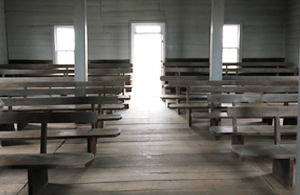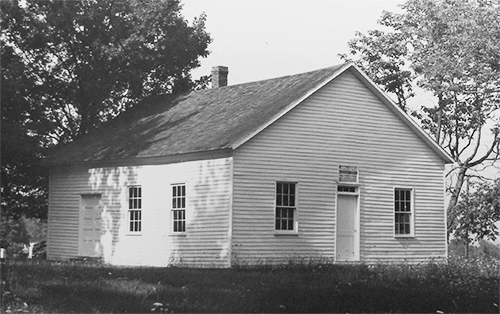The Historic Blue River Quaker Settlement in Salem Indiana
 The Beginning of Blue River Friends
The Beginning of Blue River Friends
Quakers (or Friends) are members of a Christian religious movement that started in England in the 17th century. As early as 1808 Quakers arrived in Washington County, Indiana in search of homes for themselves and their people. Most of them were from the slave-holding states of North Carolina and Virginia. As many as 8,000 Quakers migrated to Ohio, Indiana and Illinois following a law passed in North Carolina that stipulated that any slaves who were freed could immediately be re-enslaved. According to North Carolina Yearly Meetings during this time period 784 families received certificates of removal from North Carolina and began their journey to Indiana.
Quaker Caravans of 15-20 covered wagons made the seven week long journey to their new home from North Carolina. Matthew Coffin entered the area in 1809 and was soon followed by the Truebloods, Hobbs, Morris and other Quaker families. These families established a settlement in the area just northeast of Salem. Other names of early settlers were Godlove Kemp, Andrew Pitts, Samuel Lindley and William Lindley, Joseph Reyman, Cadwallader Jones, Daniel Zink, Dr. Simeon Lamb, Christopher Harrison, Jonathan Lyon, Moses Hoggatt, James Rodman and James Young.
In the year of 1815, the Friends who had settled in the Blue River neighborhood, felt a concern to have a meeting established. After making a formal request through Lick Creek monthly meeting in Orange County, that being the nearest and probably the only monthly meeting then established in this part of the country. Lick Creek Monthly Meeting was established in 1812. Lick Creek monthly meeting sent a request to West Branch quarterly meeting held in Ohio to request to have a monthly meeting established at Blue River in Salem.
God’s Spirit lives within Each Person
At the very center of the Quaker faith lies the concept of the Inner Light. Broadly speaking, the concept of the Inner Light is twofold. Firstly, the Inner Light discerns between good and evil. It reveals the presence of both in human beings, and through its guidance, offers the alternative of choice. Secondly, the Inner Light opens the unity of all human beings to our consciousness. Friends believe that the potential for good, as well as evil, is within everyone.
Quakers’ Testimony of Simplicity
Early Friends believed that it was important to avoid fanciness in dress, speech, and material possessions, because those things tend to distract one from waiting on God’s personal guidance.
Inner beauty reflects in the Friends Discipline: It is urged that Friends be watchful to keep themselves free from self-indulgent habits, luxurious ways of living and the bondage of fashion - undue luxury often creates a false sense of superiority, causes unnecessary burdens upon both ourselves and others, and leads to a neglect of the spiritual life.
By observing and encouraging simple tastes in apparel - we help to do away with the unholesome rivalry and we learn to value self-denial. True simplicity consists not in the use of particular forms, but in foregoing over-indulgences, in maintaining humility of spirit, and in keeping the material surroundings of our lives directly serviceable to necessary ends, even though these surroundings may properly be characterized by grace, symmetry and beauty.
 In addition to the simple dress and freedom from luxurious ways, the simple construction of their churches, referred to as Meeting Houses, is evident in the Hicksite Friends Meeting House located just east of Salem, Indiana.
In addition to the simple dress and freedom from luxurious ways, the simple construction of their churches, referred to as Meeting Houses, is evident in the Hicksite Friends Meeting House located just east of Salem, Indiana.
Within the meeting house there is no display of ornamentation such as stained glass, elaborate wood carvings, crucifixes, or instruments of music because the Quakers hold the belief that God’s Spirit lives within each person and the manifestation of his being is evidenced in the life of each person. There have been few alterations in the Hicksite Friends Meeting House and thus it appears very much as it did originally in 1815.
Quakers Arrive in Large Numbers in the Salem Area
In the year 1812 a small band of Quakers in the Blue River Settlement built a crude meeting house on the land owned by Albert Hollowell. This building was made of hewned logs, the windows were of greased paper, and there was no chimney. A hole was left at the top of the roof for smoke to escape and a hole was dug in the ground for a fire. There was no floor and the seats were made from slabs of wood with pegs inserted for legs.
When the North Carolina Quakers had received assurances from their counterparts in the Indiana Territory, that General William Henry Harrison, had driven the hostile Indians and the waring away from this area (by late 1813), a great influx of new Quaker families began to arrive. Many of them settled around the already established Quaker homesteads of Samuel Lindley and Matthew Coffin, in what became known as, the Blue River Friends Settlement.
The people constituting the Blue River Meeting of Friends were from; Pasquotank, Perquimans, Guilford and Randolph counties of North Carolina with a few exceptions, those being from Pennsylvania, Rhode Island and several removed from Lick Creek Monthly meeting.
The peak of Quaker immigration to the Blue River Friends Settlement was 1815-1816.
Many Quaker Homesteads can be identified in the Blue River Quaker Settlement by the tall Larch, Hemlock and Southern White Pine Trees. These huge monuments came as saplings carried from North Carolina in the stirrups of their saddles.
Importance of Quaker Meeting Houses
 A Friends meeting house is a meeting house of the Religious Society of Friends (Quakers), where meeting for worship is usually held. Typically Friends meeting houses do not have steeples. Quakers have always reserved the word church to mean the body of people who make up the worshipping community: Quakers do not use the word church to refer to the bricks and mortar of a worshipping community.
A Friends meeting house is a meeting house of the Religious Society of Friends (Quakers), where meeting for worship is usually held. Typically Friends meeting houses do not have steeples. Quakers have always reserved the word church to mean the body of people who make up the worshipping community: Quakers do not use the word church to refer to the bricks and mortar of a worshipping community.
Meeting Houses built in a traditional style usually had two meeting rooms: one for the main meeting for worship, and another where the women's business meeting may be held (often referred to as the women's meeting room). Meeting houses of this style usually have a minister's gallery at one end of the meeting room, where traditionally those traveling in the ministry would have sat, with an elders bench immediately in front of this. Wooden benches facing this occupy the rest of the room, often with a gallery for extra seating.
Meeting Houses established from Blue River Friends Settlement
Says Elias Hicks Trueblood: in "The Prophet of Blue River" this southern part of Indiana seemed full of Quakers: perhaps twenty or thirty meetings had been established, and Blue River could have been called the mother of them all."
- Mount Pleasant (10 miles from Blue River Hicksite) Cemetery Still Exists - 1818
- Poplar Grove near Seba Washington County - 1825 (Two Miles from Blue River Hicksite)
- Honey Creek - 1820 - (Preparative school)
- Driftwood / Sand Creek - 1820 (Bartholomew County) - Cemetery Still Exists - 1820
- White River - 1820 - (Preparative school)
- Union Meeting - 1820
- White Lick Creek - 1823
- Beech Grove - 1824
- Fairfield - 1825 - (Preparative school)
- New Berry - (down Lick Creek) - 1826
- Vermillion - 1826 (Preparative school)
- Leatherwood (know as Elevatus - (Preparative school)
- Sugar Grove - 1826
- Fairland - 1827
- Highlands Creek - 1839 (Six miles west of Blue River)
The Historic Blue River Quaker Settlement was established in 1815









































































